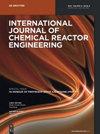An experimental evaluation of green surfactants to stabilize silica nanofluids in saline conditions and its application in CO2 absorption
IF 1.6
4区 工程技术
Q3 Chemical Engineering
International Journal of Chemical Reactor Engineering
Pub Date : 2023-08-10
DOI:10.1515/ijcre-2022-0241
引用次数: 0
Abstract
Abstract Conventionally, it has been established that the salt ions have the tendency to reduce the surface charge of nanoparticles (NPs) and render them unstable, regulating the stability of nanofluids in a saline environment has been an issue for a long time. To overcome this problem, our work presents the application of a novel green surfactant obtained from Fenugreek seeds of an anionic nature for use as a stabilizing agent for 0.1 wt% silica nanofluids prepared using in DI water. To prevent phase separation, it is imperative to stabilize silica nanofluid solution during their use for subsurface applications. Thus, salt tolerant nanofluids can be prepared and utilized for further applications in enhanced oil recovery and carbon storage etc. The surfactant was extracted from fenugreek seeds by using Soxhlet extraction technique. The liquid solution of extracted surfactant thus derived was dried in hot air oven in order to get the powdered surfactant. The results obtained from dynamic light scattering and zeta-potential, the use of the green surfactant, even in limited concentration (0.2 wt%) not only increases the stability of the nanofluid (from 2 to 12 h) but also lowers the influence of salt, if it is present in moderate concentration (up to 2 wt% NaCl). In addition, when 4 wt% NaCl is dissipated in the solution, the presence of surfactant allows the nanofluid to remain stable for up to 4 h. Furthermore, the surfactant-enriched silica NPs showed higher CO2 absorption than conventional NPs due to higher surface area and better bubble breakage, paving the way for future field deployment of green-surfactant stabilized silica nanofluids for gas storage and enhanced oil recovery applications.绿色表面活性剂在盐水条件下稳定二氧化硅纳米流体的实验评价及其在CO2吸收中的应用
摘要传统上,盐离子有降低纳米颗粒表面电荷并使其不稳定的趋势,调节纳米流体在盐水环境中的稳定性一直是一个问题。为了克服这个问题,我们的工作介绍了一种从胡芦巴种子中获得的新型绿色表面活性剂的应用,该表面活性剂具有阴离子性质,可作为0.1 使用在DI水中制备的wt%二氧化硅纳米流体。为了防止相分离,在二氧化硅纳米流体用于地下应用期间,必须稳定二氧化硅纳米流体溶液。因此,可以制备耐盐纳米流体,并将其用于提高采收率和储碳等方面。采用索氏提取技术从胡芦巴种子中提取表面活性剂。将提取的表面活性剂的液体溶液在热风炉中干燥,得到粉末状表面活性剂。通过动态光散射和ζ电位获得的结果,使用绿色表面活性剂,即使在有限浓度(0.2 wt%)不仅增加了纳米流体的稳定性(从2到12 h) 而且如果盐以中等浓度(高达2 wt%NaCl)。此外,当4 wt%NaCl在溶液中消散,表面活性剂的存在使纳米流体保持稳定长达4 h.此外,富含表面活性剂的二氧化硅纳米颗粒由于具有更高的表面积和更好的气泡破碎性,显示出比传统纳米颗粒更高的CO2吸收率,为未来用于储气和提高采油应用的绿色表面活性剂稳定的二氧化硅纳米流体的现场部署铺平了道路。
本文章由计算机程序翻译,如有差异,请以英文原文为准。
求助全文
约1分钟内获得全文
求助全文
来源期刊
CiteScore
2.80
自引率
12.50%
发文量
107
审稿时长
3 months
期刊介绍:
The International Journal of Chemical Reactor Engineering covers the broad fields of theoretical and applied reactor engineering. The IJCRE covers topics drawn from the substantial areas of overlap between catalysis, reaction and reactor engineering. The journal is presently edited by Hugo de Lasa and Charles Xu, counting with an impressive list of Editorial Board leading specialists in chemical reactor engineering. Authors include notable international professors and R&D industry leaders.

 求助内容:
求助内容: 应助结果提醒方式:
应助结果提醒方式:


